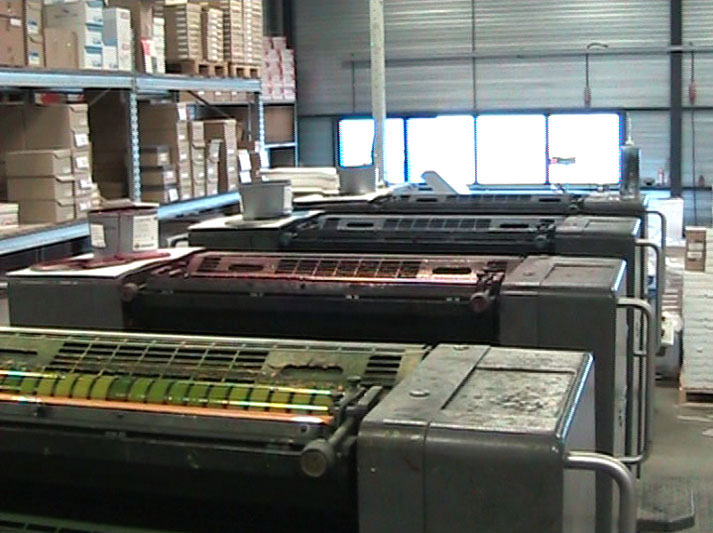You may also be wondering how one can mix the color magenta. According to some painters, blending the primary colors of red and blue paint is a way to make magenta. However, red also consists of yellow, so the result of the mixture would be more violet than magenta.
Mixing yellow with magenta to get red orange and created by mixing more magenta to red orange to make the color red. John Muir, an educator and nature artist said in his book that magenta, rather than red, would be a primary color as primary colors can be created by mixing of other colors. It is said that using magenta as a primary color can help in painting with a multitude of colors that the primary color of traditional red wouldn't help you in achieving. If you are looking for a shade of vivid purple, magenta and cyan mixed together will help you achieve this. If you want a shade of hot pink, add the color of magenta to white color and get it mixed together. If you are using watercolors, add magenta to water.
If instead of magenta, you would've used red here, you wouldn't have gotten a light pink, but a light red. In the world of colors and painting, some shades of colors are likely to fade. These are called fugitives and magenta is known to be a notorious fugitive. Organic magenta is hardly ever permanent and the hues of magenta are rarely found in laboratory-made pigments.
What Happens When You Mix Cyan And Yellow Pigment Other prominent combinations being yellow and cyan, green and blue, cyan and magenta, yellow and blue, and magenta and yellow. The mixing of colored physical substances corresponds to subtractive color mixing, hence it corresponds to our intuition about mixing colors. To explain the mechanism, consider mixing red paint with yellow paint. The red light, not being absorbed, reflects off the paint, and is what we see. This same mechanism describes the color of material objects – note that light is not a material object – and so applies to the yellow paint as well. Making recourse to the figure above demonstrating additive color mixing, one sees that yellow light is composed of an mixture of red and green light.
When we mix the two paints, the resulting substance has red paint and yellow paint. The yellow paint absorbs all colors except for red and green. However, the red paint will absorb the green reflected by the yellow paint. The red paint can be said to subtract the green from the yellow paint.
The resulting paint reflects only red light and so appears red to our eyes. This results in a darker and desaturated color compared to the color that would be achieved with ideal filters. In subtractive mixing of color, the absence of color is white and the presence of all three primary colors makes a neutral dark gray or black. The secondary colors are the same as the primary colors from additive mixing and vice versa. Subtractive mixing is used to create a variety of colors when printing or painting on paper or other white substrates, by combining a small number of ink or paint colors.
Black can be approximated by mixing cyan, magenta, and yellow, although real pigments are not ideal and so pure black is nearly impossible to achieve. Cyan, magenta and yellow are the primary colors of pigments, combining to make black. Red, blue and green are the primary colors of light, combining to make white.
Yellow pigment absorbs blue light and cyan absorbs red light. When white light passes through yellow and cyan ink layers on paper and reflects back off the paper, all but the green light is absorbed so we see green being reflected. In order for green light to be absorbed and not reflected it would have to pass through magenta pigment. Paints, inks, photographs, and dyes get their colors from pigments. A pigment is a material that absorbs some colors of light and reflects other colors. Stone Age cave paintings were made with natural pigments from colored earth and clay.
Over the centuries, natural pigments have been obtained from many sources, including metal oxide compounds, minerals, plants, and animals. Today's artists use paints made from natural pigments as well as from synthetic, or manufactured pigments. The primary colors of pigments are cyan, yellow, and magenta. You can mix varying amound of these primary pigment colors to make almost any other color. As pigments are mixed together, more colors are absorbed and fewer colors are reflected. When two or more pigments are mixed together, the colors absorbed by each pigment are subtracted out of the light that strikes the mixture.
When cyan and magenta are combined, blue is formed. The secondary colors of pigments are red, green, and blue. Any two colors of pigments that combine to make black pigment are complementary colors of pigments. The first thing you have to understand that red, blue and yellow are not complementary colors. In additive color mixing red, blue and green are the scientific primaries, and as weird as it sounds, yellow is a secondary color of mixing red and green lights. By convention, the three primary colors in additive mixing are red, green, and blue.
In the absence of light of any color, the result is black. If all three primary colors of light are mixed in equal proportions, the result is neutral . When the red and green lights mix, the result is yellow.
When green and blue lights mix, the result is a blue. When the blue and red lights mix, the result is magenta. "When the blue flashlight circle intersects the green one, there is a lighter blue-green shape," he says. So the distinction in color systems really comes down to the chemical makeup of the objects involved and how they reflect light. Additive theory is based on objects that emit light, while subtractive deals with material objects like books and paintings.
"Subtractive colors are those which reflect less light when they are mixed together," says Raiselis. Those names are already used as the primary colors for light..The primaries for pigments must be distinct to differentiate them from red and blue. We have a clear idea of a hue in our head when when say "red". Color names become less useful when they are used to describe a larger arc of color across the color wheel. It is easier for us all to envision the same color when we say cyan. Just as it would be confusing to describe red as an orangeish violet, describing cyan as a greenish shade of blue makes no sense .
An external source of illumination is assumed, and each primary attenuates some of that light. Combining all three primaries absorbs all the light, resulting in black. For real pigments, the results would be somewhat complicated by opacity and mixing behavior, and in practice adding a fourth pigment such as black may be helpful. It is said that in the RGB color model, the color of magenta is made by using equal amounts of red and blue light. In the addictive colors of the RGB color wheel, magenta is seen to be right in the middle of red and blue.
The color red which is said to be a warm color can be made by combining magenta with a small amount of yellow. This means, trying to make magenta would require all three primary colors of magenta, cyan blue, and a very small amount of yellow in it. If you want to make the color of magenta using acrylic paint, use transparent red and blue as magenta is a transparent color. Magenta is also said to be confused as pink and purple when in reality it is red and purple or pink and purple. In terms of the RGB color wheel, the color is halfway red and purple and composed equally of blue and red .
An additive color is one created by mixing red, green and blue light in different combinations. Additive colors begin as black and become brighter as you add different light. In contrast, a subtractive color is made by partial absorption of different colors of paint or ink. They begin as white and take on the appearance of the added colors or their mixtures.
You start with white, and you're putting a layer of something on top of it, which allows a certain wavelength of light through but takes away everything else. So whatever you add, it always gets darker, and changes colour in a certain way. When you mix light, you're starting with black, and you're adding something. If you think a the way a TV works, it sends out red and green and blue and makes a coloured picture. It's a fundamentally different way of doing something.
An interesting aside to that is that when you take a picture with your camera, it records red, green and blue. When you print it out, the printer has to convert it into something called CMYK, which is cyan, magenta and yellow. Printers use a different palette because when you add things subtractively, you end up with different colours. In theory, if you mix the cyan, magenta and yellow together, you get black, although in practice you don't quite, so they have to add black to make everything work.
As we have discussed above, magenta is said to be a family of colors that occurs from the blue and red light. The color of magenta is perceived to be bright pink. It is known as a broad range of colors that are much brighter than any other pinks resulting from red tinted with white. A mix of red and blue that is closer to blue is seen as purple.
Mix red, green, blue, yellow, violet, light cyan, alizarin crimson in equal intensity to magenta for getting various interesting hues. I must again make it very clear that I have never claimed in any thread that red, yellow, and blue are the best mixing primaries that mix any color IRL. It is like traveling from any point A to point B by the shortest direct route. Thinking in these terms reduces the variables, it eliminates the biases that all real world pigments have. I learn where each and every color I use resides, in relation to red, yellow, and blue, even my cyan and magenta.
I mentally start from a single discreet color and not from a mixture of colors. Now I know what my cad red or my pr209 or violet, cyan or whatever will do. I know that the idea that red, yellow, and blue are the primary colors is wrong.
Most monitors, phones, and telelvisions use additive color mixing to create their range of colors. The illustration below shows how a monitor uses red, gree, and blue colors dots on the screen to create different colors. The photograph on the left shows the screen as it actually appeared with a small section at the intersection of the red, blue and green circles as indicated. Blowing up the image by taking a photograph really close to the screen, as shown in the photograph on the right, shows the individual color dots on the screen. When you mix colors using paint, or through the printing process, you are using the subtractive color method.
The primary colors of light are red, green, and blue. If you subtract these from white you get cyan, magenta, and yellow. Mixing the colors generates new colors as shown on the color wheel, or the circle on the right. As you mix colors, they tend to get darker, ending up as black. The CMYK color system is the color system used for printing.
If you mix red, green, and blue light, you get white light. Red, green, and blue are referred to as the primary colors of light. Mixing the colors generates new colors, as shown on the color wheel or circle on the right. As more colors are added, the result becomes lighter, heading towards white.
RGB is used to generate color on a computer screen, a TV, and any colored electronic display device. When you combine red, green and blue together, you get white. Did you know, red, yellow, and blue are the three primary colors? Magenta is perceived as a mixture of red and violet or blue light. A color that is a mixture of violet and red has captured the attention of many throughout the years.
It is quite a fascinating color as its very existence is debated over. Apart from its mysterious appearances, magenta is a color of balance and harmony. It is often considered to be spiritual in nature and used in Feng Shui. Magenta looks great when it's combined with other pink hues or bright yellows or blues. Combining it with pink gives more of a feminine feel to the person opting for magenta.
Have you ever mixed red and blue paint only to find you have "mud" instead of purple? Want to know how to create any resin color you may need for a project? Lack of good information has made mixing colors difficult in the past. Before the invention of color photography, color mixing was not very well understood.
Many believed that red, yellow, and blue were the primary colors, from which you could make all others. Now, we know that magenta, yellow, and cyan are the true primaries and give much better results. The photographs below illustrate subtractive color mixing using lights.
The picture on the left shows the red, green, and blue lights sourses. Where they overlap the wall will look white in the picture on the right. Since the different light sources are in different positions, they shadows cast for each light source will be in a different position. The blue light source will cast the right shadow, the green source will cast the middle shadow, and the red light source will be on the left. Look closely at the shadows for the pinky of the hand.
The shadow for the blue light is yellow because the blue is blocked. The shadow for the green light is magenta because the green is blocked. The shadow for the red light is cyan because the red is blocked.




























No comments:
Post a Comment
Note: Only a member of this blog may post a comment.